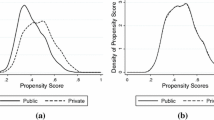Abstract
Taking advantage of newly available data on a standardized national examination for secondary school students in Thailand, this study attempts to explain the variation in the average performance of students using school and local characteristics. Special emphasis is placed on trying to understand the asymmetric success factors of public and private secondary schools, and the possible effects of their coexistence. Results from a propensity score matching model suggest that private schools may create positive spillovers on the academic performance of students attending public schools located in the same district. The main implication from the research is that a more careful discussion about the impact of the ongoing education reforms on private schools is needed.
Similar content being viewed by others
References
Afonso A., St. Aubyn M. (2006) Cross country efficiency of secondary education provision: A semi-parametric analysis with nondiscretionary inputs. Economic Modeling 23(3): 476–491
Angrist J., Bettinger E., Bloom E., King E., Kremer M. (2002) Vouchers for private schooling in Columbia: Evidence from a randomized natural experiment. American Economic Review 92(5): 1535–1558
Assadullah M. N., Chaudhury N., Dar A. (2007) Student Achievement Conditioned upon School Selection: Religious and Secular Secondary School Quality in Bangladesh. Economics of Education Review 26: 648–659
Bedi A. S., Garg A. (2000) The effectiveness of private versus public schools: The case of Indonesia. Journal of Development Economics 61: 463–494
Biddin, R., Zimmer, R. (2005). Is charter school competition in california improving the performance of traditional public schools? In RAND Education Working Paper Series WR-297-EDU, September 1995.
Bureau of Policy and Planning (2007). Educational statistics. http://www.info.bopp.moe.go.th/info_50/title.html. Accessed June 2009.
Doner, R. F. (2008). The Thai Government and Thailand’s uneven economic development. In Paper presented at the 2008 Thailand Development Research Institute Year-End Conference, November 29–30, Ambassador City, Jomtien, Chonburi, Thailand.
Hoxby, C. M. (1994). Do private schools provide competition for public schools? In NBER Working Paper No. 4978, December 1994.
Hoxby C. M. (2003) School choice and school competition: evidence from the United States. Swedish Economic Policy Review 10: 9–65
Jepsen, C. (1999). The effects of private school competition on student achievement. In Working Paper, Northwestern University, November 1999.
Jimenez E., Sawada Y. (2001) Public for private: The relationship between public and private school enrollment in the Philippines. Economics of Education Review 20(4): 389–399
Ladd H. F. (2003) Comment on Caroline M. Hoxby: school choice and school competition: evidence from the United States. Swedish Economic Policy Review 10: 67–76
Office of the Private Education Commission. (2009). Statistical data page. http://www.opec.go.th/index.php?name=menu11&file=readmenu11&id=8. Accessed June 2009.
Rosenbaum P. R., Rubin D. B. (1983) The central role of propensity score in observational studies for causal effects. Biometrika 70(1): 41–55
Warr P. (2007) Long-term economic performance in Thailand. ASEAN Economic Bulletin 24(1): 138–163
White H. (1980) A heteroskedasticity-consistent covariance matrix estimator and a direct test for heteroskedasticity. Econometrica 48(4): 817–830
World Bank. (2006). Thailand social monitor: improving secondary education. World Bank Office, Bangkok, 2006.
Author information
Authors and Affiliations
Corresponding author
Rights and permissions
About this article
Cite this article
Wongsurawat, W. Education reform and the academic performance of public and private secondary school students in Thailand. Educ Res Policy Prac 10, 17–28 (2011). https://doi.org/10.1007/s10671-010-9093-2
Received:
Accepted:
Published:
Issue Date:
DOI: https://doi.org/10.1007/s10671-010-9093-2




